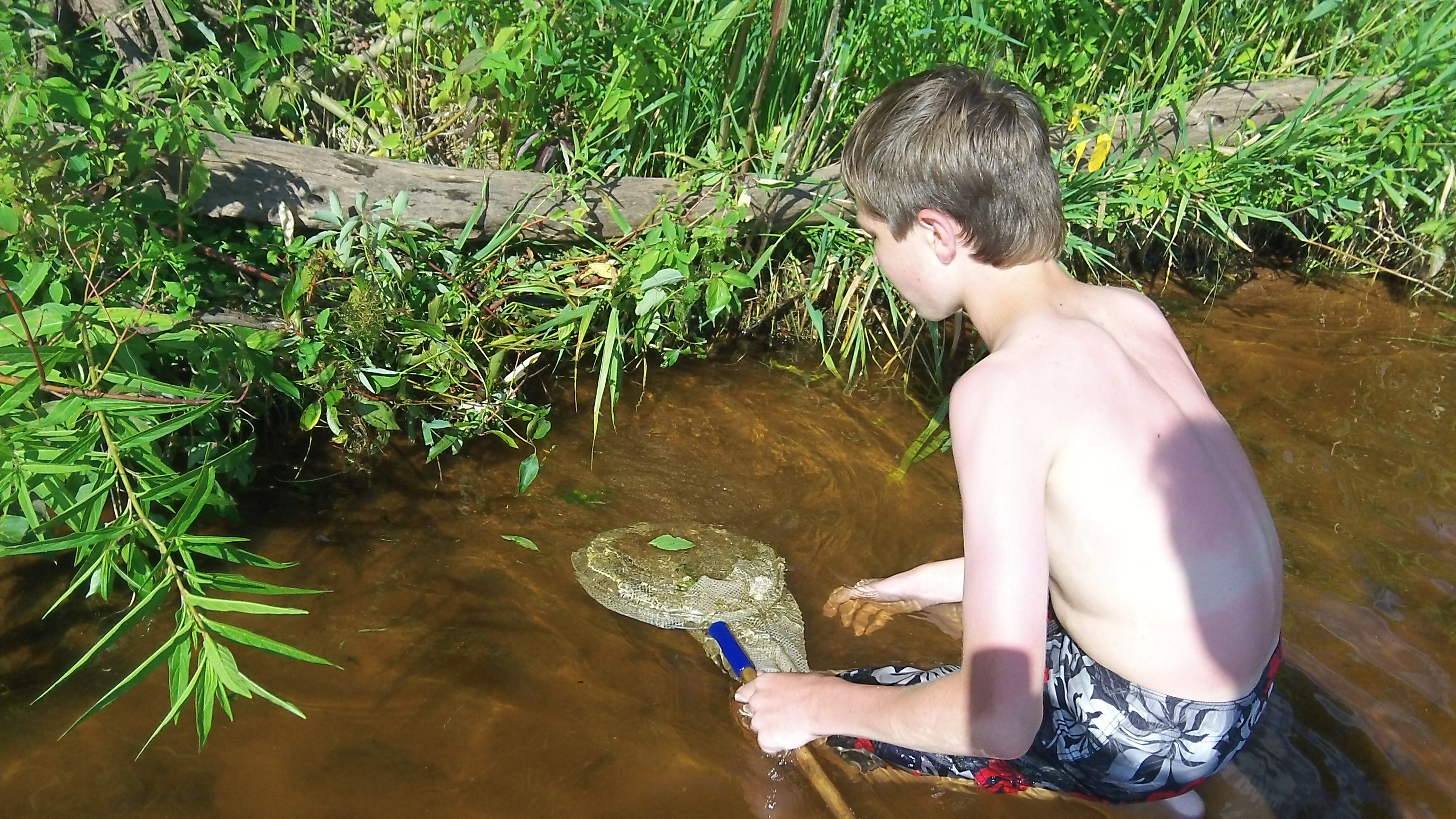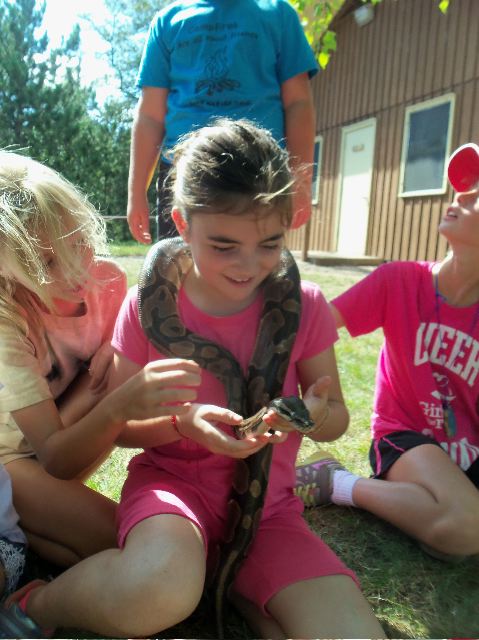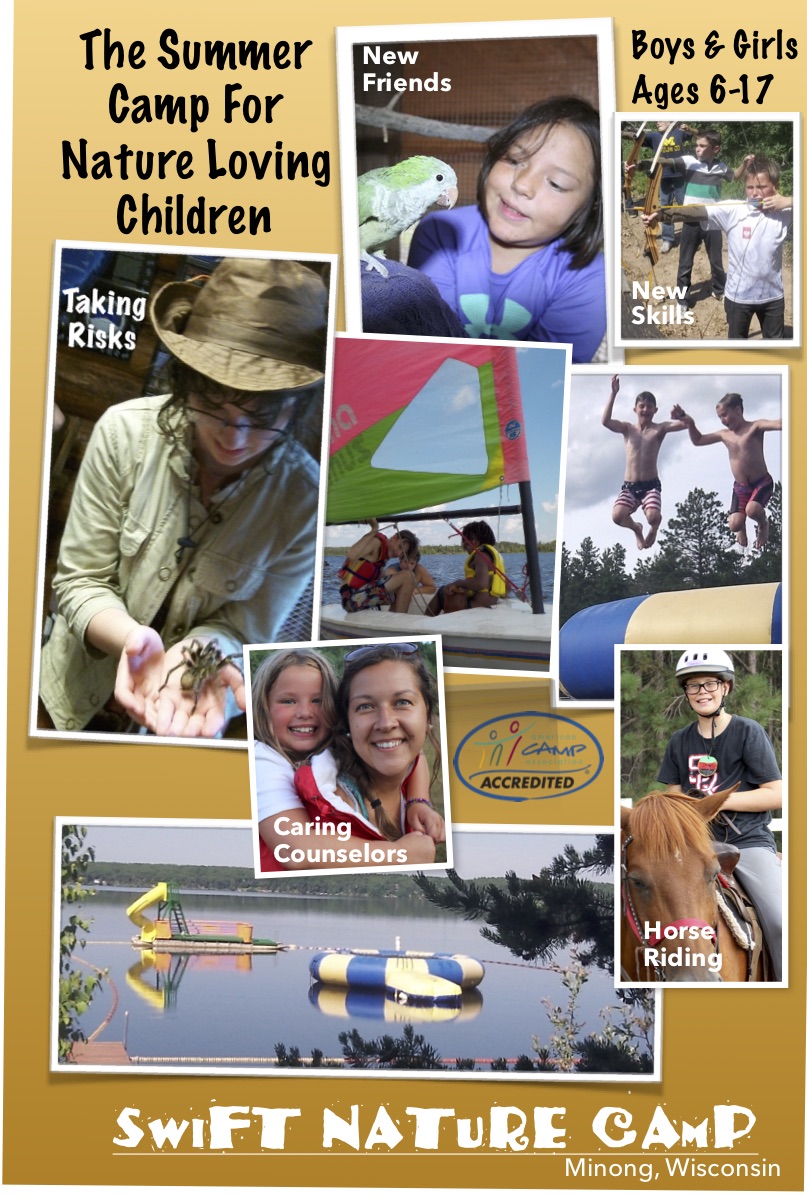Displaying items by tag: Science camp
As we near Earth Day 2012 it is important that
we all realize that the planting of 1 tree can make a difference.
Read more about How trees change our life
The information provided is in reference to urban forests, but these benefits and values also apply to rural forests.
Canopy, or tree canopy, is a term used to describe the leaves and branches of a tree or group of trees. In an urban forest, tree canopy is important to the potential benefits the forest may provide. In general, the more area it covers and the denser the canopy, the more benefits the trees can provide. Although one tree is better than none, 100 are better still. Whether the benefits are from one tree or many trees, they are all still real and most can be quantified in some way. Often, forest benefits are divided into three categories: social, economic, and ecologic. It is difficult to divide the benefits that the urban forest canopy provides into these categories because so many benefits fall into more than one.
Social Benefits
Just as with a rural forest, an urban forest provides many benefits. Numerous studies have been done about the social
and psychological benefits of “green” in urban environments. The findings of the studies make a strong case for the
importance of urban forests. Urban public housing residents who lived in buildings without trees and grass nearby were
asked about how they cope with major life issues. They reported more procrastination and assessed their issues as more
severe than residents with green nearby.
A study done with children with Attention Deficit Disorder (ADD) found that children with ADD were better able to focus
and concentrate after playing in natural, green settings, than in settings where concrete was predominant.
Apartment buildings with high levels of greenery have been shown to have approximately half the number of crimes
than those with little or no greenery. The results proved true for both property crimes and violent crimes. A similar study
found that residents living in areas without nearby nature reported more aggression and violence than those living with
nearby green. In addition to these specific studies, access to nature also provides humans with other social benefits.
Parks and other green spaces provide a space for people to play, walk, jog, birdwatch, or just sit quietly. These activities
are good for our physical health in a society that is increasingly sedentary. It is also good for our mental health by
providing a place to unwind. Trees also reduce noise levels.
Economic Benefits
The economic benefits of urban forests are increasingly being documented. Economics often becomes the language
used when it comes to urban forest management. Budgets of municipalities must cover an array of services, and the
benefits of an urban ecosystem must often be proven to secure funding. In a study that considered the costs and
benefits of municipal forests in five U.S. cities, the researchers found that for every dollar spent on trees, the benefits
returned were worth from $1.37 to $3.09. A little math tells us this is clearly a good investment.
Trees save money through reduced energy costs. Cities create what is referred to as a heat island. The concrete, asphalt,
buildings, and other surfaces absorb and hold heat from the sun. During hot summer days, cities can be five to nine
degrees warmer than surrounding areas. Shading, evapotranspiration, and wind speed reduction provided by trees help
conserve energy in buildings. A study conducted in Minneapolis, Minnesota, showed that trees placed in the proper
location can reduce total heating and cooling costs by eight percent.
Homeowners not only reduce costs of heating and cooling their homes, but increase the value of their property by
planting trees. Research suggests that property value can increase three to seven percent when trees are present. Trees
also make homes and neighborhoods more desirable places to live. One economic benefit that urban trees can provide,
but often don’t, is one based on products. Municipalities and tree services across the country have come up with ways
to use the wood that is cut from an urban forest. Products range from specialty furniture, to musical instruments, to
lumber for park shelters, to artwork. The income from selling products from the wood of trees being removed could be used to defray the cost associated with the removal, making trees an even better investment.
Trees and Climate Change
The information about how trees impact climate change is taken from the National Arbor Day website
http://www.arborday.org/globalwarming/treesHelp.cfm, and the American Forest Foundation website
www.americanforests.org/resources/climatechange/
Deciduous trees, planted on the west, east and south sides, will keep your house cool in the summer and let the sun
warm your home in the winter, reducing energy use.
Just three trees, properly placed around a house, can save up to 30% of energy use.
Trees or shrubs planted to shade air conditioners help cool a building more efficiently, using less electricity. A unit
operating in the shade uses as much as 10% less electricity than the same one operating in the sun.
Neighborhoods with well-shaded streets can be up to 6–10° F cooler than neighborhoods without street trees, reducing
the heat-island effect, and reducing energy needs.
Shaded parking lots keep automobiles cooler, reducing emissions from fuel tanks and engines, and helping reduce the
heat-island effect in communities.
Trees absorb carbon dioxide (CO2), the primary gas causing global climate change. Trees retain the carbon (C) from the
CO2 molecule and release oxygen (O2) into the atmosphere. The retained carbon makes up half the dry weight of a tree.
Forests are the world's second largest carbon reservoirs (oceans are the largest). Unlike oceans, however, we can grow
new forests. One acre of forestland will sequester between 150 - 200 tons of CO2 in its first 40 years.
 Recently I was poking around the web and I saw this article about the benefits of choosing a science summer camp program over some other type of summer camp. Being that this is what Swift Nature Camp does, I found it extremely informative and I hope you will too.
Recently I was poking around the web and I saw this article about the benefits of choosing a science summer camp program over some other type of summer camp. Being that this is what Swift Nature Camp does, I found it extremely informative and I hope you will too.
What about science?
Science Summer Camps and programs let students get close to areas of scientific inquiry in a way that isn't always possible in the classroom.
Does science come to mind when you think about summer camp? All of our campers know It should,
You might be surprised to learn that hundreds of camps and programs across the United States offer science as part of their summer-fun lineup—and in support of an increasing committment to supporting and strengthening science, technology, engineering, and math (STEM) skills.
Like all other summer camps, science-related summer programs are an American right of passage: hours of fun with friends, away from parents, no textbooks, no tests, no homework. The difference is that a summer science camp also offers students of all ages an opportunity to reallyexplore science in all its hands-on, fun, goopy, messy, glory, without the burden of needing to know the 'right' answer for Wednesday's quiz.
Science camps come in a wide variety of formats. There are day and residential camps focusing on every aspect of science and engineering you can imagine: robotics, chemistry, the environment, zoo animals, architecture, space science, and dinosaur fossils, to name just a few! These programs use fun and play to help teach and introduce science and engineering concepts. For example, a week-long day camp focusing on amusement park physics might have kids exploring centripetal force, and kinetic and potential energy, while riding real amusement park rides and building their own mini versions from LEGO blocks, buckets, string, or foam tubing. When done right, science camp is a combination that is super fun and engaging, and fosters learning and creativity.
Why attend a science camp?
Science camps fall under the umbrella of what is commonly called informal science learning. Recent studies show that informal science learning is one of the most effective ways people learn science. Students who participate in these types of activities are more likely to have an above-average understanding of science, and pursue science-related careers.
For younger children, science camp can introduce them to many different areas of science and give them the confidence and inspiration to embrace science at school. Older students, who are already interested in science, may use science camp as a way to explore what a specific science-related career would be like, or to meet mentors and role models in the field. Such connections could lead to other opportunities, like internships, or become a featured event on a resume or college application.
For all students, science camp can be the opportunity to explore a branch of science that might not be available in their school, like marine biology or aeronautics, or to cover a topic more in depth than they'd otherwise be able to.
How do I choose a summer science camp or program?
Through innovative hands-on activities and demonstrations, students can explore a range of scientific fundamentals and areas of science at summer camp, from chemistry and microbiology to aeronautics, electronics, and computer science.
Choosing a summer science camp is similar to choosing any other type of camp. You have your usual considerations about cost, distance from home, and amount of time, along with the question of finding the "best fit." For science camps, the "best fit" often boils down to figuring out what science topic(s) are of interest and finding a camp that does a good job of implementing those.
Figure out what science topics are of interest.
- Older children might already have a clear preference. Perhaps they're keen on video games and would love to go to a camp where they could design and program one. Or maybe they're into hiking and wildlife and are looking for an outdoor experience as a junior park ranger. Their hobbies and reading choices are often a good indicator of their interests.
- Younger children might not yet have a clear preference. If they don't, then look for camps that offer a wide variety of science and engineering topics for them to explore. For example, a day camp that has a new science theme every week, or a balance camp that has a blend of science, arts, and physical activities.
Determine the level of "academics" you want.
- Science camp should always be fun. A good science camp will allow students plenty of time to do hands-on exploration. This is part of the informal component. How much additional formal education a science camp has varies. Programs that incorporate lectures from distinguished professors or professionals might be appropriate, inspirational, and informative for older students who are interested in a specific field. Younger students are more likely to benefit from group activities, projects, and interactions with informed camp counselors rather than lectures.
Search for camps that fit your needs.
Once you know the range of science topics you'd like the camp to cover, the level of academics, the general geographic location, and the time and money commitments that are right for your family, you're ready to start searching.Cogito and The Connectory are two great national science camp directories and a fantastic place to begin your search.
-
Local parenting magazines and websites might also have lists of camps in your area.
-
Science museums, zoos, aquariums, planetariums, and state or national parks are also great resources, as they often run their own camps and/or link to science camps with similar interests.
-
Many colleges and universities also run summer science camps. A simple search for "summer science camp" on a local academic institution's website is a good way to find these.
-
Simple web browser searches can also turn up a wealth of information.
 Make sure you choose a camp or program with qualified counselors.
Make sure you choose a camp or program with qualified counselors.
Once you've located some camps that meet your search parameters, you should do some legwork to make sure that the counselors—the people the campers interact with all day long—are knowledgeable about science. For example, a knowledgeable counselor can transform a simple day of splashing in the creek into an adventurous treasure hunt for local plants and animals, andincorporate substantive and engaging lessons about food chains and the interconnectivity of different habitats.
Ask the camp or program director questions aimed at making sure the counselors have had ample formal training in the subject area(s) and excel at explaining the science in an engaging, age-appropriate manner. Ask the camp or program director questions aimed at making sure the counselors have had ample formal training in the subject area(s) and excel at explaining the science in an engaging, age-appropriate manner.
Register Early!
- While summer might seem a long way off, it's time to start thinking about summer camps. Many top camps offer "early bird" registration discounts in the January-March timeframe (check camp websites for specific camp deadlines).
Find Out More
- National Research Council of the National Academies. (2009). Learning Science in Informal Environments: People, Places, and Pursuits. Retrieved December 1, 2010, from http://www.nap.edu/openbook.php?record_id=12190&page=1#
- Folk, John H., and Dierking, Lynn D. (2010, November-December). The 95 Percent Solution: School is not where most Americans learn most of their science. American Scientist. Volume 98, Number 6, Page: 486. Page: 486
- Summer Camp Advice- Empowering Parents to Make Informed Decisions

permalink=”http://www.swiftnaturecamp.com/blog”>

Catching frogs is one of favorite things to do at this children’s summer camp. One of the best hunting spots is the lamp poles at night. You see the frogs come up from the pond at night looking for food and all the bugs hanging around the light will do just fine.
One might wonder are you eating all these favorite catches. Nope they gan spend on night up at the Nature Center Zoo where they hang with the other animals anc catches then its back to where they were caught at. Next summer, join us for some serious frog catching..
permalink=”http://www.swiftnaturecamp.com/blog”>

click to see more photos
permalink=”http://www.swiftnaturecamp.com/blog”>




Do you enjoy Nature? Do you like to take pictures?
Now it’s your chance to make the call! The National Wildlife Federation needs your vote!
Their Magazine has selected the finalists for this Photo Contest. The theme is “Nature in My Neighborhood.” Now we need YOU to help choose the winner!
Vote for your favorite image today! The top vote-getter receives an official NWF field guide and, if not already a member, a free one-year membership to National Wildlife Federation. But we need to hear from you soon: Voting ends April 15!
Visit: Swift Nature Camp Website
permalink=”http://www.swiftnaturecamp.com/blog”>
The Sierra Club, through its volunteer John Muir Education Committee, operates the John Muir Youth Award in the U.S.A. Interested schools, nature centers, youth camps, or individuals are welcome to participate! The first John Muir Youth Award recipients in the USA were 19 students from the John Muir School in Portage, Wisconsin, located near Muir's boyhood home, and was awarded in June, 1997. Read on to learn how to enter!
permalink=”http://www.swiftnaturecamp.com/blog”>
|
The Five Challenges
To obtain the John Muir Youth Award, you must successfully complete five challenges:
1. Discover A Wild Place
Following Muir's maxim that "None of Nature's landscapes are ugly so long as they are wild," look for a wild place naear you. A "Wild Place" could be any relatively natural area from the back-yard garden, to the local park or a nature reserve. Young children may well start close to home and progress to more adventurous and remote sites as their knowledge and abilities grow. Older children will want to find true wilderness nearby.
|
permalink=”http://www.swiftnaturecamp.com/blog”>
| The Wisconsin No Child Left Inside Coalition is working to develop an Environmental Literacy Plan for Wisconsin that will address the environmental education needs of Wisconsin's pre-kindergarten through twelfth grade schools and will pay special attention to creating more opportunities to get kids outside. The Plan will recommend a comprehensive strategy to ensure every child graduates with the environmental skills and knowledge needed to contribute to a sustainable future.
Wisconsin has a strong environmental education foundation already established, with active schools, supporting organizations, and abundant opportunities to get outside in rural and urban settings. The Environmental Literacy Plan will build upon these strengths, and suggest priorities for present and future attention. It will lay out the next steps towards fulfilling on our State's commitment to ensure all people in Wisconsin are environmentally literate. Currently, the Wisconsin NCLI Coalition is made up of representatives from: the Wisconsin Department of Public Instruction, Wisconsin Center for Environmental Education, Wisconsin Environmental Education Board, Wisconsin Environmental Education Foundation, Wisconsin Association for Environmental Education, Wisconsin Department of Natural Resources, Wisconsin Environmental Science Teachers Network, Milwaukee Public Schools, the Green Charter School Network, and the Environmental Education and Training Partnership. State Superintendent Evers has formally asked the Coalition to develop the Environmental Literacy Plan for Wisconsin. Wisconsin’s Environmental Literacy Plan will be compliant with the pending national No Child Left Inside (NCLI) legislation. The No Child Left Inside Act requires States develop, implement, and evaluate a State Environmental Literacy Plan in order to be eligible to receive funding associated with the Act. Currently, the bill suggests an appropriation of $100 million to support the State Environmental Literacy Plans. You can learn more about the |







